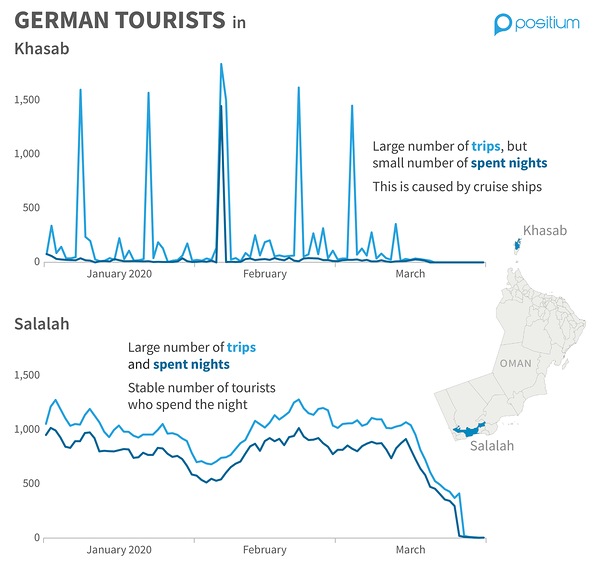For tackling this question, mobile positioning data (MPD) has proven to have many benefits over traditional data sources. For example, it allows to detect tourists who are not recorded in accommodation statistics, border surveys or by other type questionnaires. MPD allows also to distinguish between tourist types by the lengths of stay, country of origin, and give the data about movements on a daily basis. One of the recent examples originates from Oman. What seemed to be a data anomaly at first sight turned out to be a very distinctive discovery.
To learn more, read our article 'The Science Behind Generating Tourism Statistics from Mobile Positioning Data'
The time period that raised interest was from January to March in 2020. When we analysed inbound visitors in different municipalities in Oman, particularly German tourists’ numbers caught the eye. Although the northernmost province Khasab and Salalah in the south of Oman had very similar numbers of total trips made in one month, the daily visitor patterns were completely different. In Khasab, German tourists seemed to have significant peaks in the number of trips at a regular interval. However, the number of nights spent was mostly very low.
As this is an unusual pattern for foreign tourists, this required some research. A deep dive into the data revealed that this was caused by cruise ships that brought people to the area only for the daytime. Since one-day-visitors don’t require a visa for the visit, they weren’t detected from immigration or visa statistics. On the other hand a singular peak of nights spent could be explained with cruise ships staying at the port for the night.
As a comparison, the province Salalah in the south of Oman had a similar number of trips by German tourists in monthly tourism statistics which is the most common breakdown for traditional data sources, but the daily pattern of their behaviour discovered from MPD was completely different. In Salalah the number of nights spent indicator followed the trend of number of trips which means a bigger share of tourists spent more time in the area compared to Khasab. This potentially also results in more income for the service providers at Salalah.
To conclude, although both Khasab and Salalah are popular tourist destinations, they are being visited in a very different manner. Producing tourism statistics from mobile positioning data enables us to analyse and visualise the trends of visitors and showcase how contrasting they can be in different regions. The ability to discover interesting mobility patterns is one of the biggest values of MPD. The high precision of the data in space and time helps the municipalities make better decisions and plan services accordingly.
*This blog post was part of our #2022MapChallenge.
Would you be interested in learning more about mobile big data and Positium? Let's talk about what mobile big data can do to help your organisation make decisions based on population mobility.
.png)

